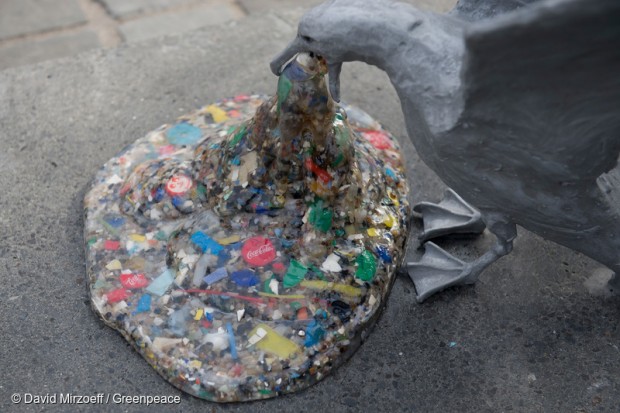Ocean plastic sculpture unveiled in central London
Fresh from opening Europe’s first underwater museum in Lanzarote, renowned marine sculptor Jason deCaires Taylor yesterday unveiled a dramatic installation focused on ocean plastic in central London.

The artwork, Plasticide, has been produced in collaboration with Greenpeace and is installed outside the National Theatre, and seeks to bring home the stark reality of plastic pollution on our oceans and marine life.
The piece features Jason’s signature pH-neutral concrete sculptures and for the first time integrates carbon-captured materials alongside recovered ocean plastics.
Featuring the distinctive style of Jason’s underwater installations, the sculpture weighs two and a half tonnes and features life-size human figures, including a cast of the artist’s daughter. Jason’s previous works include The Rising Tide, installed in the Thames near Parliament last year, and Museo Atlantico, a captivating sunken world populated by over 300 individual sculptures sunk off the coast of Lanzarote, Spain.
Plasticide will be situated outside the National Theatre for two weeks, 23rd March – 6th April.
Jason deCaires Taylor said:
“Through my work I’ve seen first-hand the deluge of plastic on our coastlines and swirling around our seas. The build-up of a man-made material like plastic in the vast expanse of our seemly untouched oceans is a visceral reminder of humankind’s devastating impact on our environment. Through Plasticide I want to bring this message back to home: our oceans, and the marine life which inhabits them, literally can’t stomach any more plastic.”
Lisa Burger, Executive Director of the National Theatre, said:
“We are delighted to host Jason deCaires Taylor’s Plasticide in order to highlight the issue of plastic pollution in our oceans.”
Louise Edge, Senior Oceans Campaigner said
“Greenpeace is proud to work with Jason deCaires Taylor to shed light on the enormous tide of plastic pollution ending up in our oceans. His sculpture, Plasticide, reflects the reality that throwaway plastic doesn’t just disappear when we are done with it, but often ends up in the ocean where it causes untold harm to marine life.
“Studies have shown that 90% of seabirds now have plastic in their stomachs. The problem highlighted in this sculpture would have seemed surreal fifty years ago, but it’s now a grim reality. All plastic is made on land and it’s here we need to see action to reduce the flow of plastic into our oceans”
Notes to editors
For further information, interviews and comment, contact:
Luke Massey, Press & Communications Officer at Greenpeace UK, luke.massey@greenpeace.org, 07973 873 155
Content available:
- Images of Plasticide, Jason deCaires Taylor’s new sculpture outside the National Theatre on London South Bank: http://media.greenpeace.org/collection/27MZIFJJAV8I3
- Footage of Plasticide, including a time lapse video of its production and interview clips with Jason deCaires Taylor, as well as footage of Jason’s previous underwater work, available upon request.
- Background pictures of ocean plastic pollution: http://media.greenpeace.org/collection/27MZIFJJAYYJJ
- Images of Jason’s previous work: http://media.greenpeace.org/collection/27MZIFJJAVJZY
Further information:
Greenpeace is campaigning for action to tackle ocean plastic pollution. Last week, Greenpeace released a report on the plastic footprints of the world’s largest soft drinks companies.
Jason would like to thanks Cleaner Ocean Upcycling Productions (COUP) for providing some of the ocean plastics used in the piece.
Previous work by Jason deCaires Taylor:
Jason is perhaps best known for creating the world’s first underwater museum in Cancun.
In September 2015, London hosted The Rising Tide, comprised of sculptures of four riders on horseback, which were installed near the bankside of Vauxhall bridge. As the water level of the Thames rose and fell with the tide, the four ghostly riders and horses slowly emerged fully into view. Jason’s most recent work is the Museo Atlantico, a captivating sunken world populated by over 300 individual sculptures sunk off the coast of Lanzarote, Spain. Examples of Jason’s work can be seen here: www.underwatersculpture.com/works/recent/
